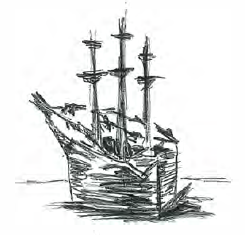Mary Galeese could clearly remember the hardships of life for her family in County Mayo, Ireland. Catholics had always been discriminated against and because of ‘penal laws’ they had no hope for advancement. Large estates and Protestant landlords from England deeply affected rural life in the West of Ireland. T errants could face eviction by landlords wishing to clear their land. The Catholic population was forced to pay tithes for the upkeep of the Established Catholic Church and evangelical Protestant missionaries tried to redeem the Irish from the errors of Popery.
Mary was born in 1845, considered the first year of the Great Famine. Most of the impoverished depended on potatoes as a food staple. In August 1845 a killer fungus started to destroy the potato crop. The green stalks became blighted and rotten and a third of the crop was ruined. Disaster struck again in 1846 when most of the crop was destroyed and led to a catastrophe for the remainder of the decade. As the death toll mounted County Mayo was seized by panic and despair. Workhouses were built to relive the appalling poverty but were soon overwhelmed by all the starving people. The government imported large quantities of maize from America as a relief measure but it had a bad effect on the digestive systems of the starving. Evictions continued and this process of clearance was aided by the passage of the Poor Law Extension Act of 184 7. With this law anyone who had more than a quarter acre of land was denied relief. Starving people were forced to abandon their holdings and go to workhouses in order to survive but many were turned away as the workhouses were full. The dying were everywhere, coffinless bodies were cared through the streets. People were buried in mass graves and some buried right where they died. To avoid disease neighbors would tumble a victims cabin around his body. Fever, dysentery and diarrhea were widespread with the greatest toll among laborers, women and children on roads and in cold, wet, boggy hills. Emigration seemed the only escape, people crowded on to any ship that was leaving. These ships were called * “Coffin Ships” as overcrowding and unhygienic conditions on board ensured that many did not reach their destination. * By 1851 it is estimated that one million people had died from the Famine and that another one million had emigrated to England, America and Australia.
The exact year of Mary’s emigration is not known but it is apparent what her family had to endure. In 1997 The National Famine Monument was unveiled in County Mayo. It is the largest bronze statue in Ireland and was crafted by John Behan. The dramatic sculpture depicts a “Coffin Ship” with skeleton bodies tangled in the rigging. A similar sculpture was unveiled in 2000, outside the United Nations building representing those immigrants who survived.
Resources
- www.mayo-ireland.ie
